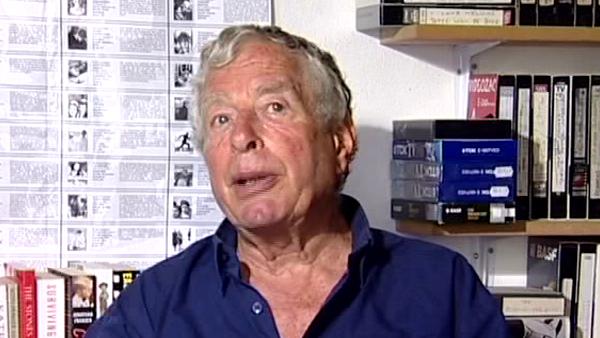NEXT STORY

The Girl in Black: Post-synching and hand-holding
RELATED STORIES

NEXT STORY

The Girl in Black: Post-synching and hand-holding
RELATED STORIES


|
Views | Duration | |
|---|---|---|---|
| 81. Tom Jones: The editing and Tony Richardson's... | 172 | 05:04 | |
| 82. The end of Woodfall | 77 | 01:41 | |
| 83. Tom Jones: Good for the careers of the crew | 86 | 00:56 | |
| 84. Artists and chemists | 49 | 03:01 | |
| 85. Meeting Michael Cacoyannis for the first time | 108 | 01:39 | |
| 86. Michael Cacoyannis' directorial style | 111 | 04:42 | |
| 87. The Girl in Black: De-blimping an Arriflex | 69 | 03:15 | |
| 88. The Girl in Black: Post-synching and hand-holding | 49 | 01:38 | |
| 89. The Girl in Black: The rescue scene and English... | 54 | 01:02 | |
| 90. The Girl in Black: Working with simple technology | 55 | 03:54 |


The Girl in Black is filmed on the island of Hydra and the interiors are done partly in Hydra and partly in Athens. So we had a method of working where we filmed in Hydra for maybe five days, maybe three days, maybe a week, and then we stopped and we went to Athens, we had a look at the rushes, and we came back to Hydra. There wasn't any pressure, you see. It was a way of making films without pressure. You could afford to stop. It wasn't like most movies nowadays where every second... once you start shooting every second costs so many thousand dollars, so you can't afford to stop. So there we could afford to stop. We could afford to work reasonable hours. We never worked more than eight hours a day. On a later Greek film we worked, that was the nicest one, we worked six to eleven, and three to six. Beautiful. But in Hydra we filmed Girl in Black is filmed in September/October, September/October/November, first part is on the island, the second part we were in Athens for some of the interiors, and it was very comfortable and very leisurely, but very efficient. Very efficient. With a low shooting ratio and it was all shot mute. That's another story because from the second film onwards, we worked with this studio called Finos Film, but the first film was not made with Finos Film. But Finos Film which was named after the owner, Mr. Finos, he had an idea, unusual in Greece, which he didn't like non-synchronous shooting. For him, everything had to be shot synch-sound, even if there were considerable difficulties. He said, no, no, we must find a way of doing it synch-sound. But that wasn't the case in The Girl in Black. I'd asked for a camera and they got an Arriflex camera from Germany, and it arrived shiny, brand new in one of those metal boxes that you now see everywhere, silver metal boxes. And it was blimped. It was a blimped camera. And I said, 'Oh, God no, I can't operate that'. It was like a monster. Because I was used to operating these little hand-held cameras. So we deconstructed the beautiful new shiny blimped camera back into a hand-holdable camera, and for that we needed a lens hood, a door, and, what else, a motor, because they were different in the blimp version. So we scoured Athens where there were lots of old Arriflex's around, very old Arriflexes, and we found- some unfortunate producer was persuaded to part with his hood, door and motor, which immobilised his own camera, and we put those on the brand new camera. Because the Arriflex is a very, in those days certainly, it was a very versatile camera, that in about 10-15 minutes you could turn it from a hand-held camera into a studio camera in a blimp for dialogue. Very handy. So we deconstructed the camera to be hand-holdable again, although the film isn't hand-held, the film is mainly shot on a tripod. There were just certain bits that were shot hand-held.
Born in Germany, cinematographer Walter Lassally (1926-2017) was best known for his Oscar-winning work on 'Zorba the Greek'. He was greatly respected in the film industry for his ability to take the best of his work in one area and apply it to another, from mainstream to international art films to documentary. He was associated with the Free Cinema movement in the 1950s, and the British New Wave in the early 1960s. In 1987 he published his autobiography called 'Itinerant Cameraman'.
Title: "The Girl in Black": De-blimping an Arriflex
Listeners: Peter Bowen
Peter Bowen is a Canadian who came to Europe to study and never got round to heading back home. He did his undergraduate work at Carleton University (in Biology) in Ottawa, and then did graduate work at the University of Western Ontario (in Zoology). After completing his doctorate at Oxford (in the Department of Zoology), followed with a year of postdoc at the University of London, he moved to the University's newly-established Audio-Visual Centre (under the direction of Michael Clarke) where he spent four years in production (of primarily science programs) and began to teach film. In 1974 Bowden became Director of the new Audio-Visual Centre at the University of Warwick, which was then in the process of introducing film studies into the curriculum and where his interest in the academic study of film was promoted and encouraged by scholars such as Victor Perkins, Robin Wood, and Richard Dyer. In 1983, his partner and he moved to Greece, and the following year he began to teach for the University of Maryland (European Division), for which he has taught (and continues to teach) biology and film courses in Crete, Bosnia, and the Middle East.
Tags: Hydra, Athens
Duration: 3 minutes, 16 seconds
Date story recorded: June 2004
Date story went live: 24 January 2008